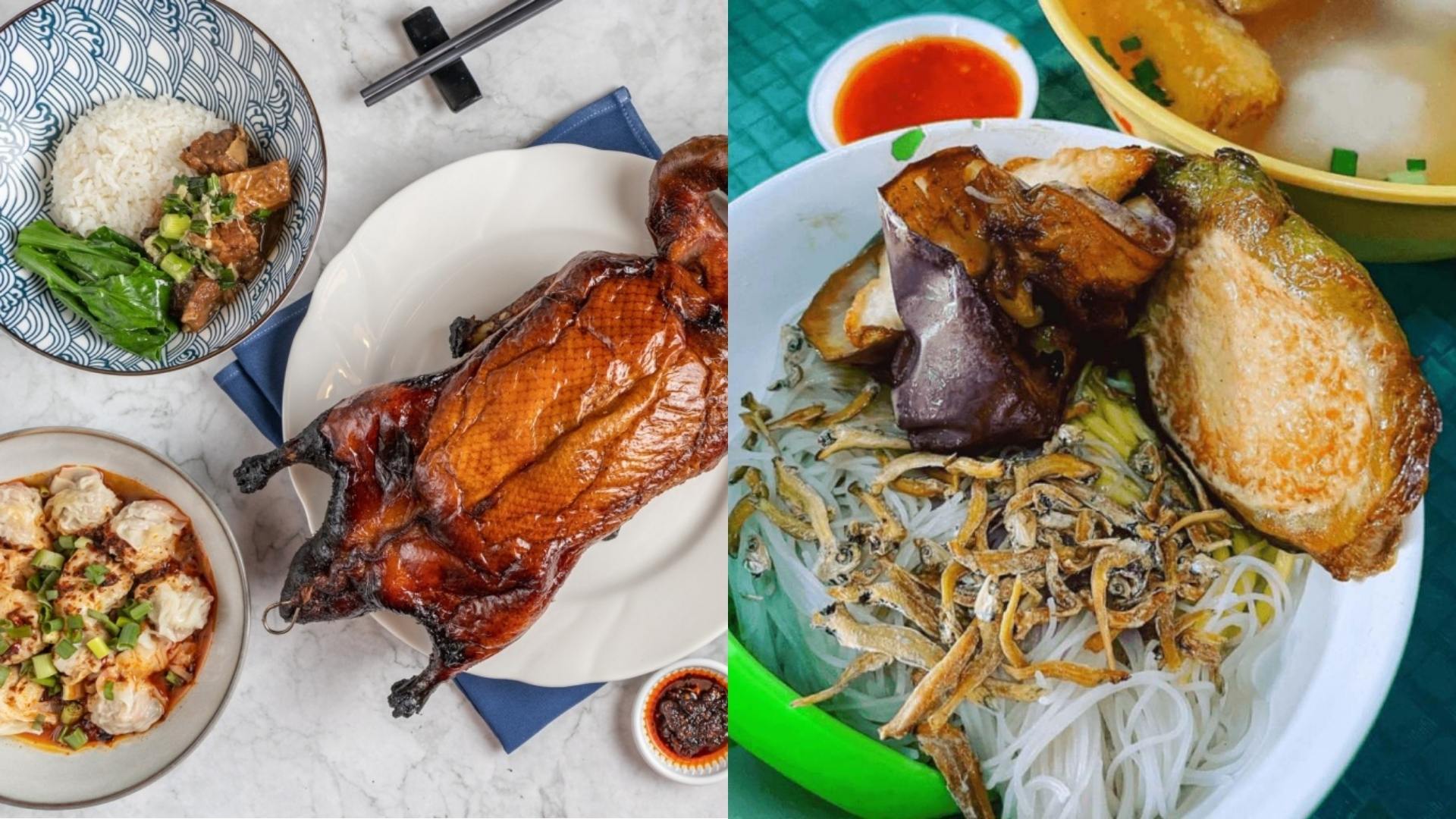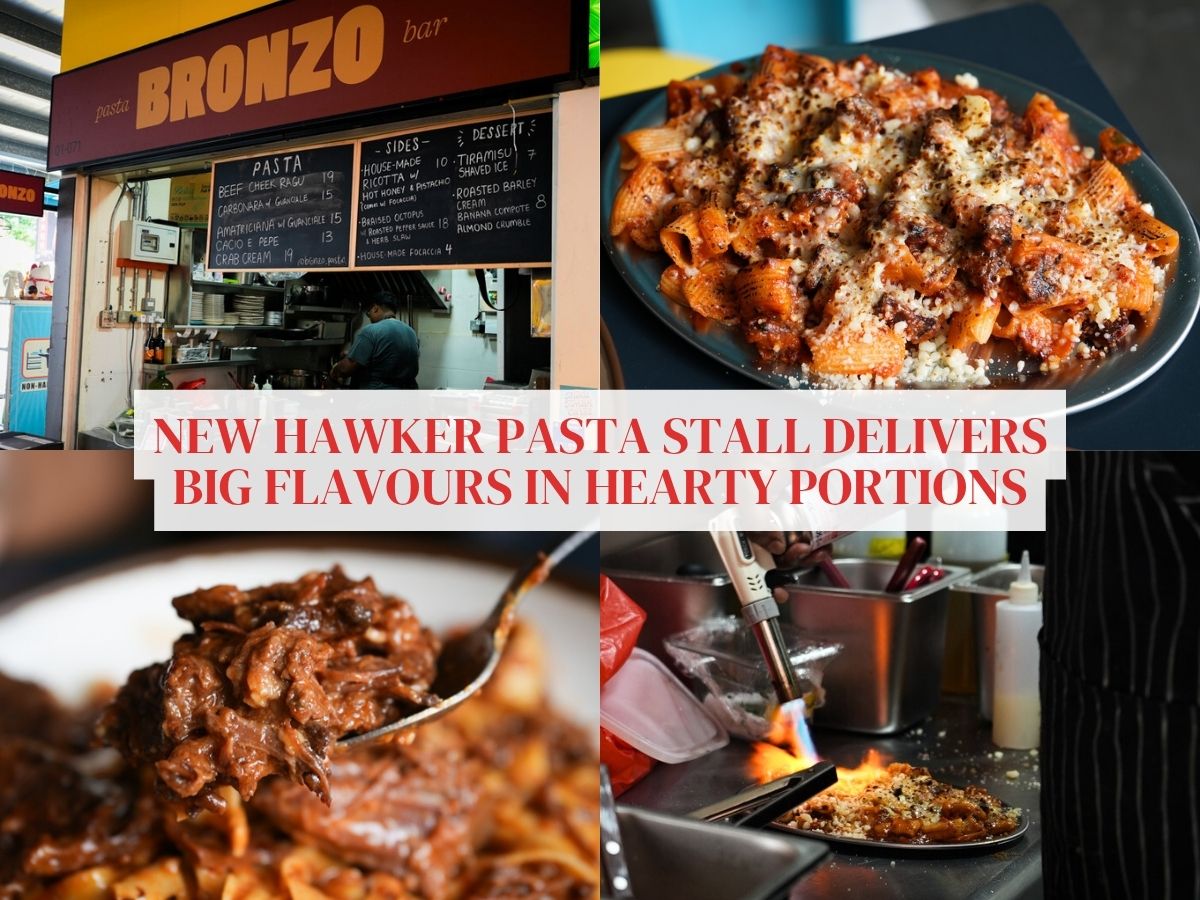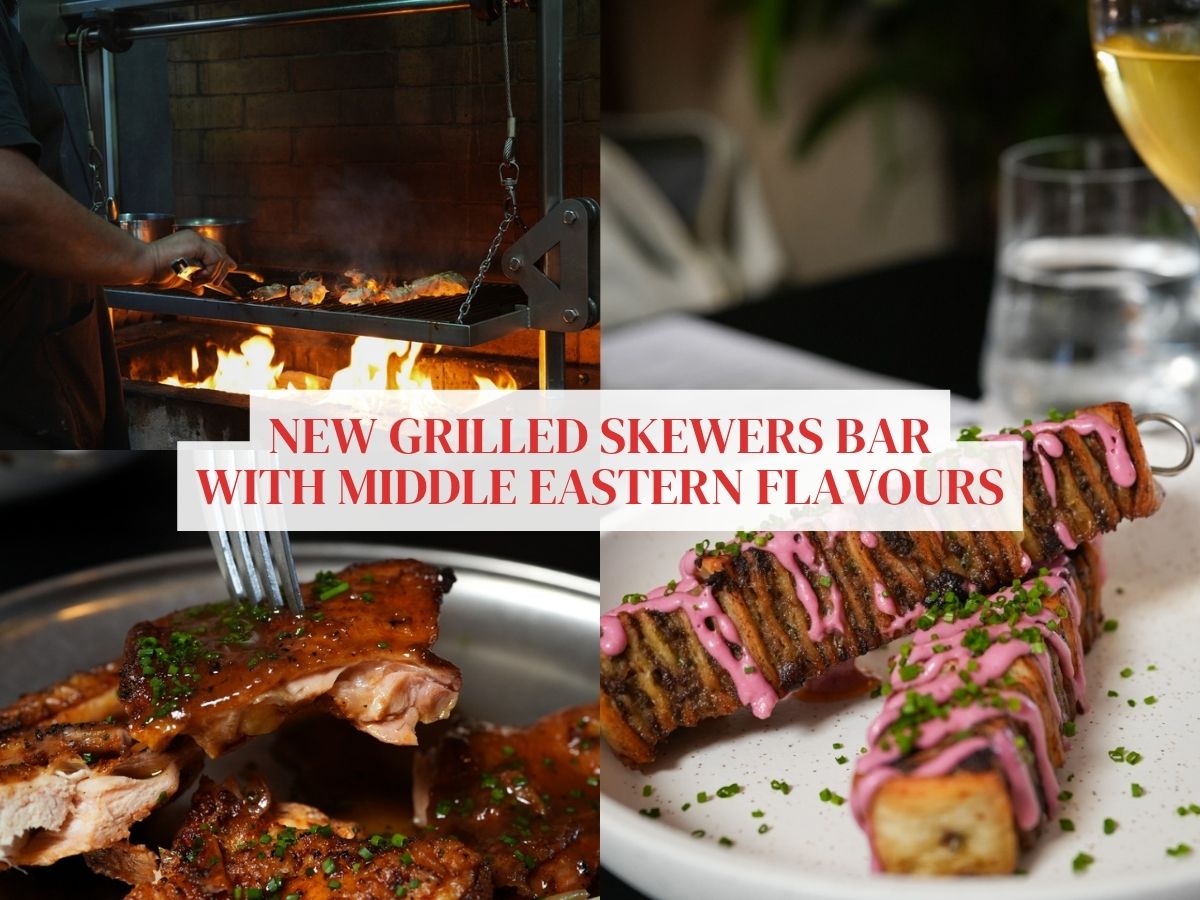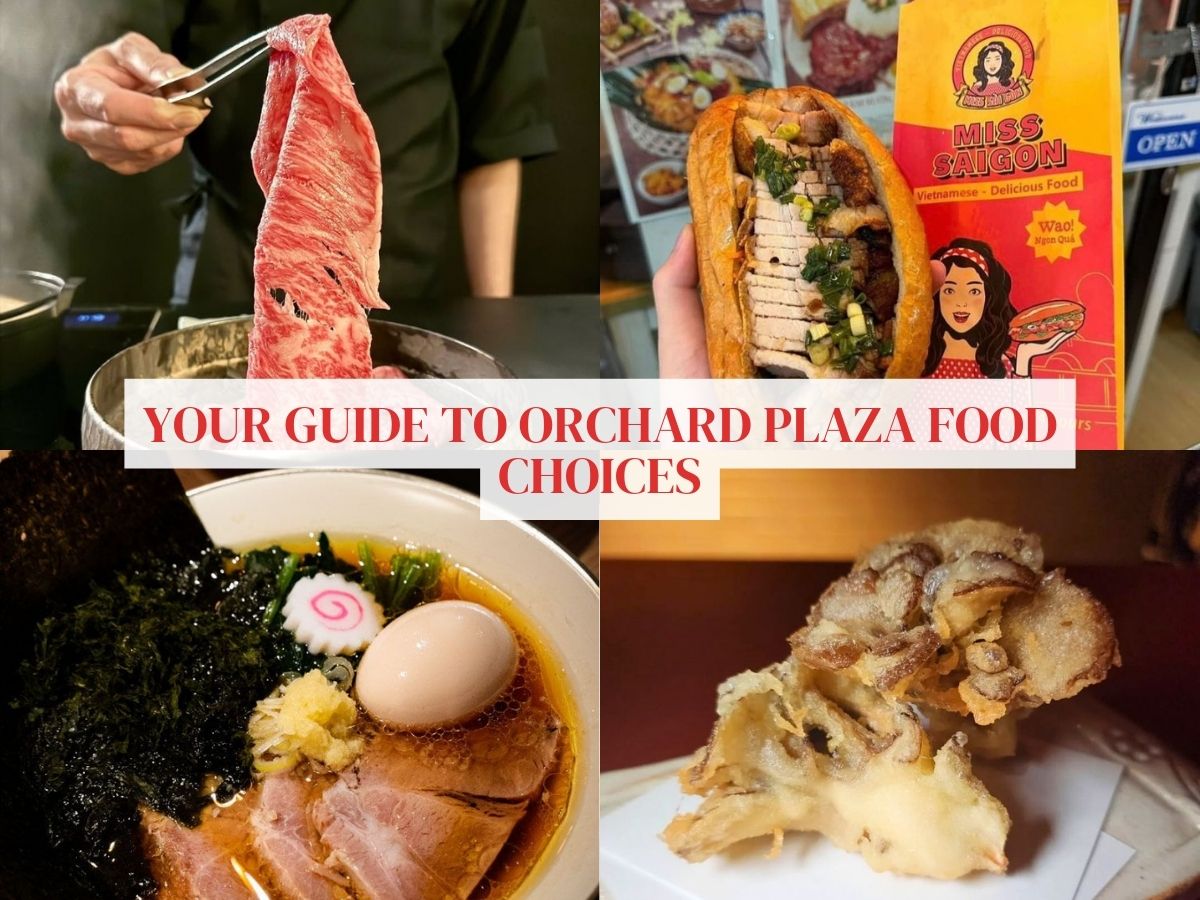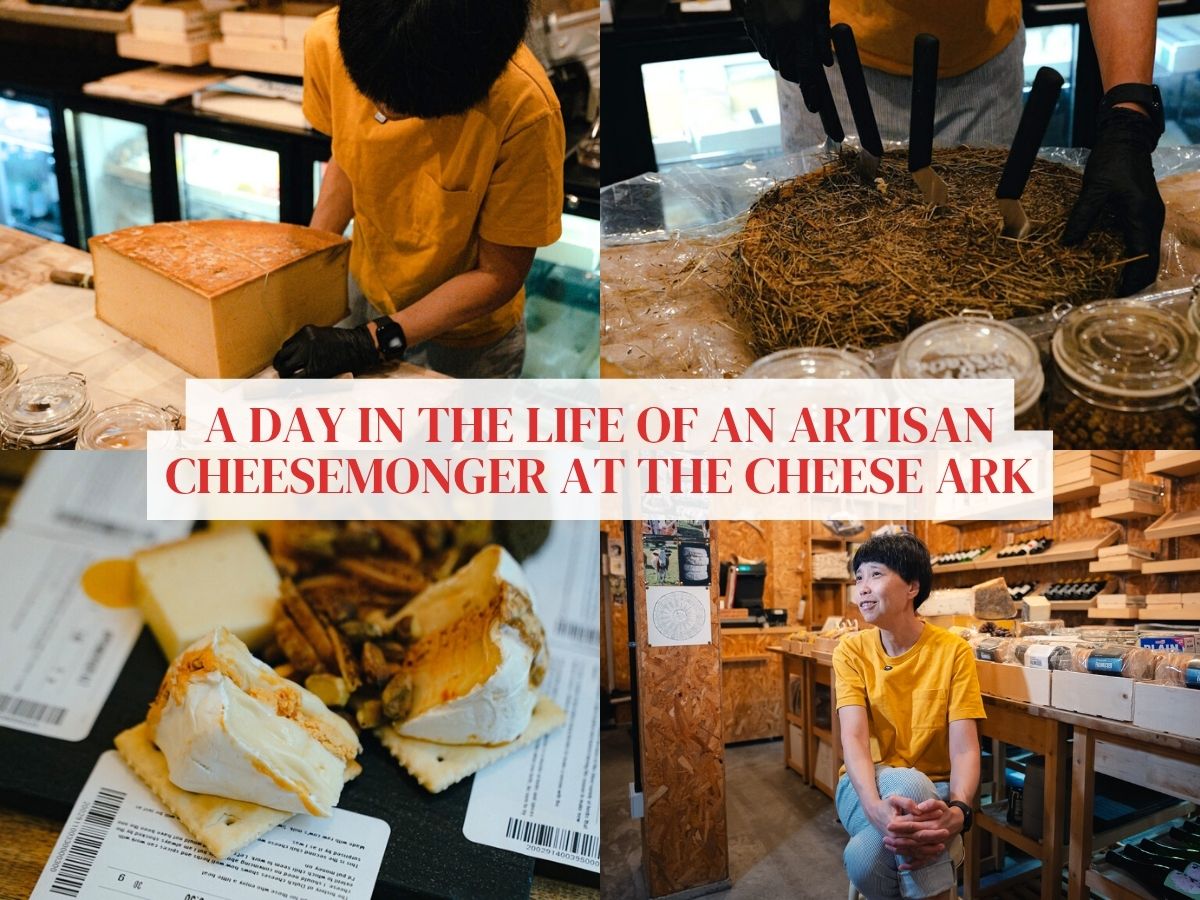17 famous hawkers you must try at Chinatown Complex Food Centre
It’s hard to miss. The colossal Chinatown Complex Food Centre is the anchor of Chinatown, sitting right in the heart of the popular district, it houses hundreds of wet market vendors and hawker stores. It is as much a tourist destination as it is a part of many Singaporean’s daily shopping and meals.
Formerly known as the Kreta Ayer Complex, it was renamed Chinatown Complex in 1984, just a little after the last street hawkers moved in, in 1983. It was said to have housed some 300 hawkers at that time.
What draws many to this Chinatown Complex Food Centre is its reputation as the mecca of Singapore’s hawker food. Some of the original hawkers are still in operation albeit helmed by the next generation, alongside some newbies, adding vibrancy into the famed food centre.
With over 200 stalls at the complex, navigation can get confusing, so we’re here to help with our guide to 17 popular stalls you should check out at Chinatown Complex Food Centre.
Tip: We’ve also divided our guide into the centre’s coloured zones, easily identified by the colour of the tables in the zone.
Green Zone
1. Pan Ji Cooked Food
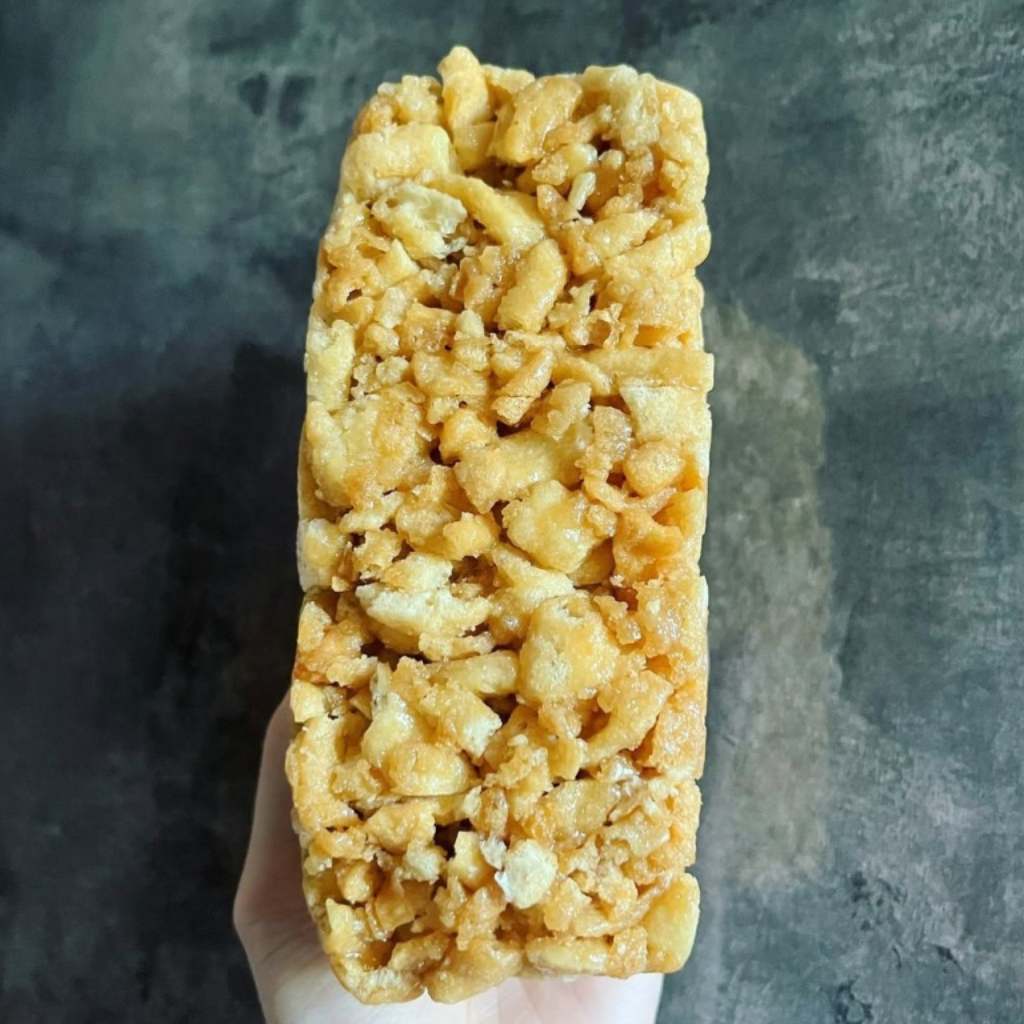
Why visit? Pan Ji Cooked Food is one of the few places left in Singapore that makes the traditional snack of sachima (or honey crackers) by hand. If you pop by, you will probably see 69-year-old Poon Sun Hay rolling, cutting and frying the dough ribbons that go into this Chinese snack within his store.
Like many of his generation, he came to Singapore with his parents from Guangdong. They had opened a Cantonese tea house in Chinatown, where Cantonese-style sachima was served. He learned and mastered the recipe from his father, who wanted to ensure that Poon, who was born without fingers on his left hand, had a skill to rely on. He was 12 then, and today, he has been preparing the snack by hand for over 40 years, and counting.
Crowd favourites: You’ll get nothing but top-notch sachima (from S$3 for a small portion) here — a crunchy yet sticky sweet exterior and a fluffy, chewy centre, with nary a hint of oil. The process of making these honey crackers is a long one, spanning two days. The dough itself takes three to five hours to prepare, and is then cooled overnight. The dough here is cut thin enough such that you get decadently crunchy and airy dough ribbons. It all comes together on the following day where a gooey mixture of sugar and maltose is poured onto the ribbons, shaped into a rectangle and cut into giant blocks you can easily bring home.
Another rare gem here is the sesame egg split (S$5) that’s also adorably known as “smiling sesame balls”, so named because the crack in the middle of this snack supposedly resembles a wide smile. This nutty cookie with a cake-like interior can be enjoyed on its own, but older folks prefer to have it with a cup of kopi.
2. Chai Wee Cuttlefish
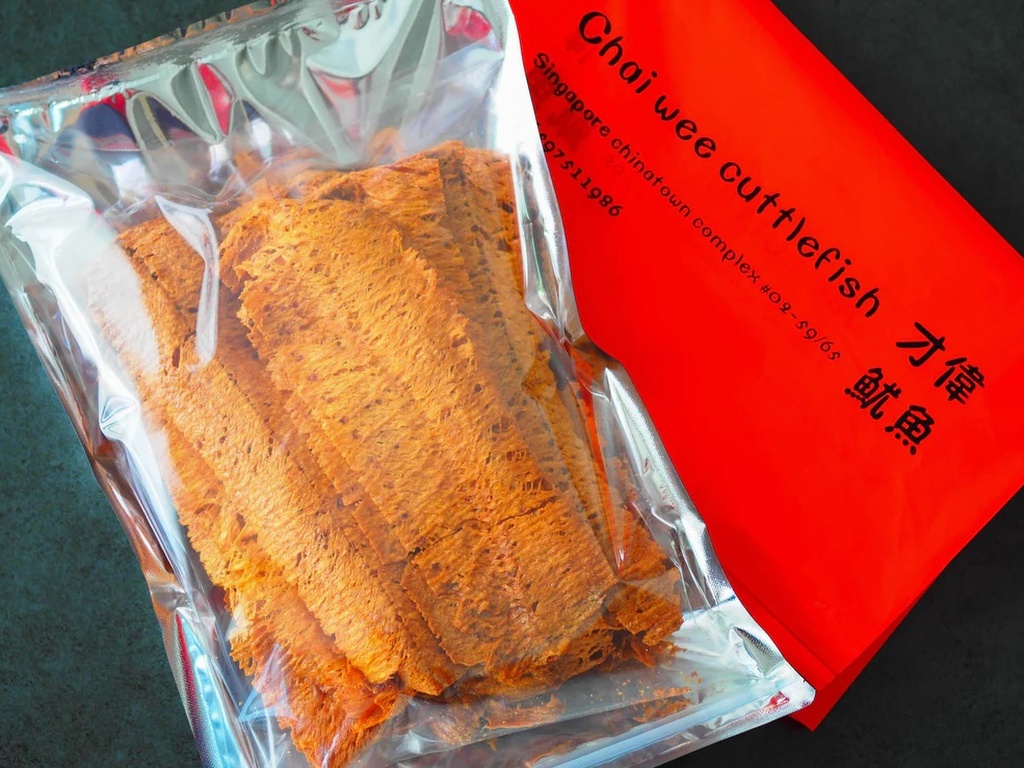
Why visit? Chances are, you’ve already heard of Chai Wee Cuttlefish but if you haven’t, it’s a brand that spans two stores within Chinatown Complex Food Centre, and for good reason, too. It has been preserving a delicious part of Singapore’s heritage — roasted cuttlefish and hand-made ear biscuits, since 1978.
The store is now run by its third-generation owner, 38-year-old Cornelius Tan, who helped turn the family-run hawker into a household brand, by digitalising the business and enhancing the store’s machinery, among many other things. Despite modernising the business, much of the work is still done by hand, following the recipe left behind by the founders (his grandparents), which you can catch a glimpse of when you swing by the store.
Crowd favourites: Its signature crispy cuttlefish (from S$11 for a regular portion) is perfect for snacking or as a gift for friends visiting from abroad. Marinated and baked fresh daily, these shatteringly crisp cuttlefish slices are sweet, salty and have just enough spice to keep you going back for more. These are also best paired with ice cold beer.
The ear biscuits (only sold in sets with the cuttlefish at S$20 with one regular cuttlefish and two packets of ear biscuits) is another childhood snack unique to southeast Asia. You’ll find variations all over the continent, all sporting the iconic striated pattern and golden brown colour that bears resemblance to pig’s ears. Its version stands out for its delicate fragrance and flavour, thanks to the use of fish sauce. Since they are made by hand, its biscuits are cut thinner for light yet satisfying crisp.
3. Chinatown Sun Seng Gourmet’s Corner
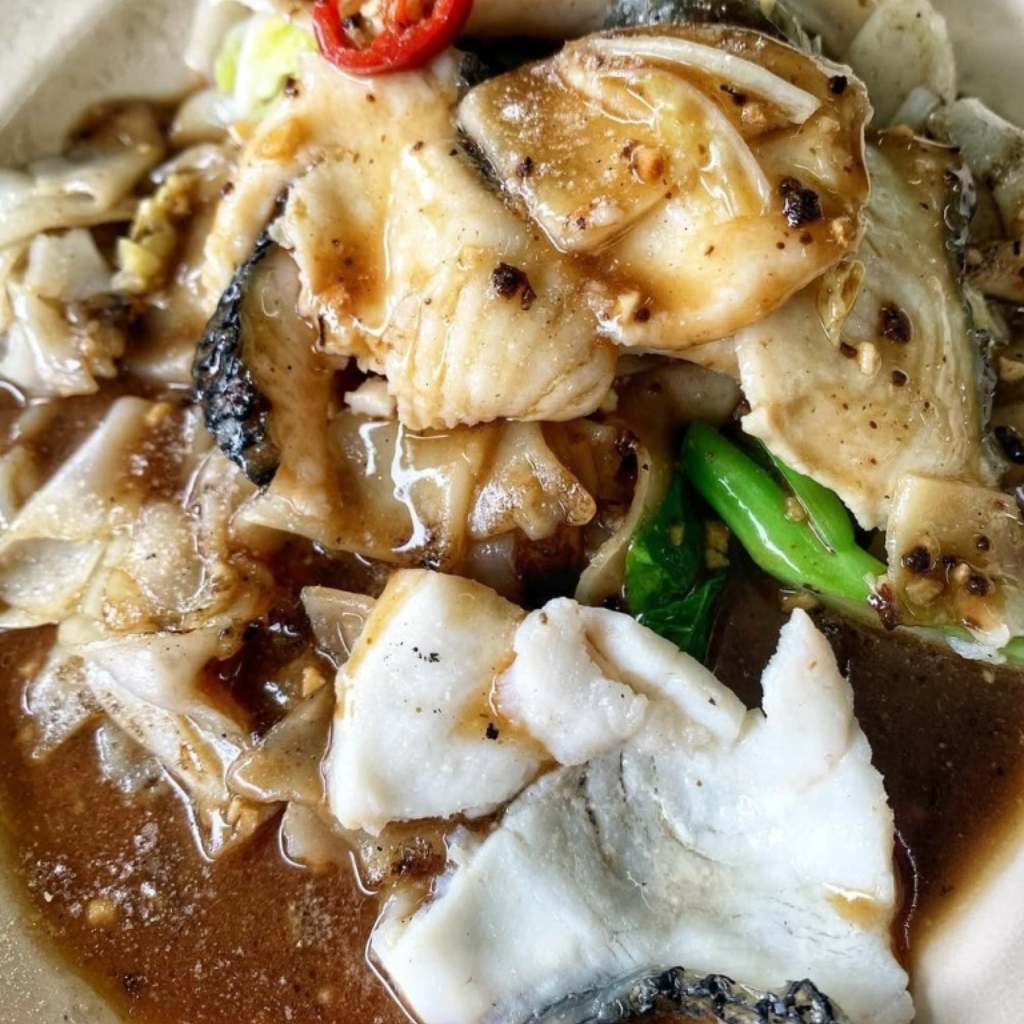
Why visit? You are missing out if you’ve not been to Chinatown Sun Seng Gourmet’s Corner. Run by Arthur Wong (or uncle Arthur to some) and his wife, this zi char store at Chinatown Complex Food Centre specialises in fish head and sliced fish dishes.
His father started the brand in the 1940s, along Mosque Street and relocated to Chinatown Complex Food Centre in 1983. Uncle Arthur has been helping out at the store since his teens and eventually took over. Swing by the store and you’ll easily spot Uncle Arthur with his cool demeanor, blasting his wok alongside an eclectic playlist in the background. It’s also not uncommon to find him and his wife lounging with their friends (and their neighbours, Smith Street Taps) at the table in front of his store after closing.
Crowd favourites: The bean sauce fish head mee hoon (from S$7) is a must-have — uncle Arthur uses only fresh snakehead fish head that’s touted for its meaty yet sweet flesh. Couple that with his expert control of fire and you get an ugly delicious mess with fermented black bean sauce that’s rich in wok hei. Those who are uncomfortable with bones can opt for the bean sauce sliced fish mee hoon (from S$6) instead.
Another favourite is the bitter gourd sliced fish (from S$6). Those who dislike the bitterness of the vegetable should give this dish a try. Fried up with the same meaty snakehead fish and fermented black bean sauce, the mild bitterness whets your appetite, before revealing a smoky, sweet and umami taste unique to the condiment.
4. Shi Xiang Satay
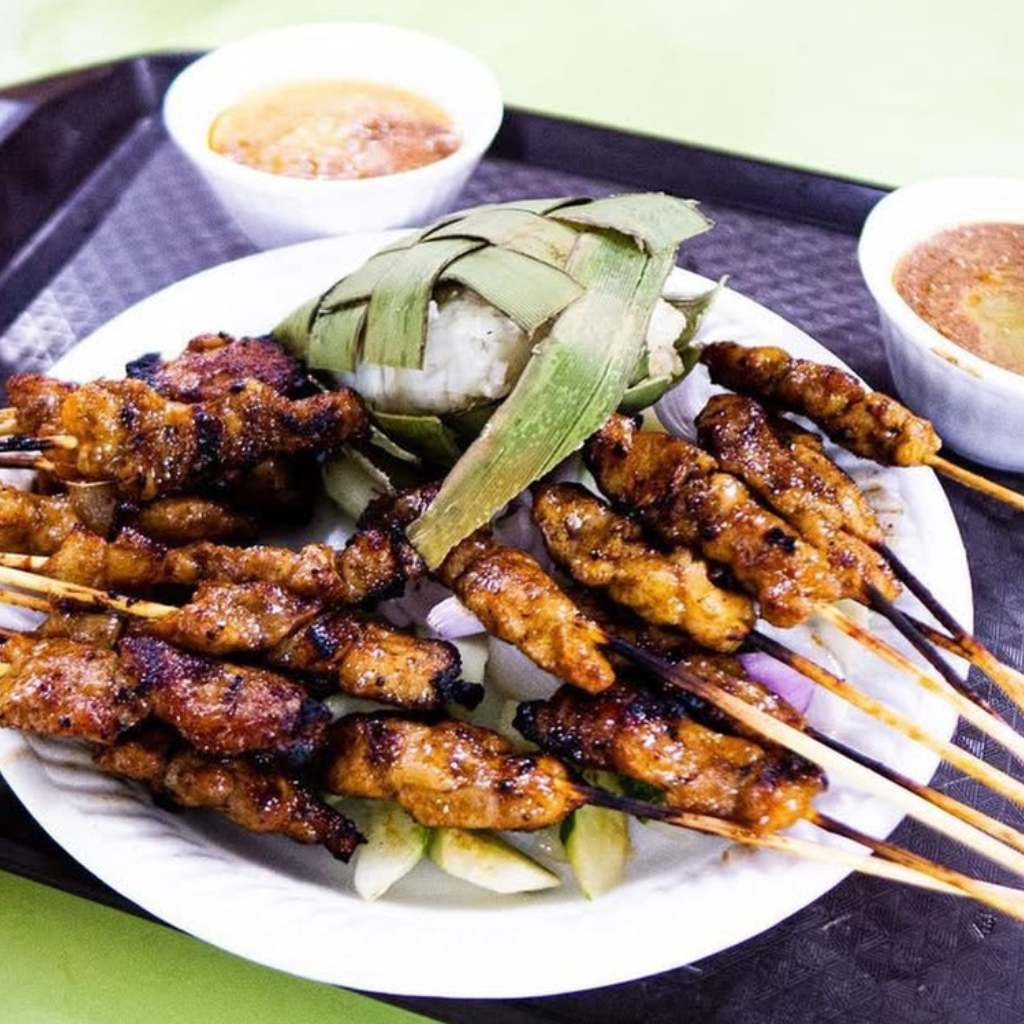
Why visit? Shi Xiang Satay comes highly recommended by its neighbours, Smith Street Taps, when I was there for a pint (or more, but who’s counting). Run by its second-generation owner Mark Young and assisted by his mother, madam Soh Jee Kee, its specialty is Hainanese-style pork and chicken satay.
The store began as a push cart along Sago Lane in 1955, before it moved into Chinatown Complex Food Complex in 1983 (as with many of the other stalls here). Madam Soh and her husband ran the store till Mark, who eventually learned and mastered the recipe, took over. The recipe has since been altered due to difficulty in sourcing previously used ingredients, but the modern recipe doesn’t disappoint — as seen from the numerous regulars and newbies flocking to the store.
Crowd favourites: With a minimum order of 10 sticks, it makes absolute sense to opt for a mix of the pork and chicken satay (S$8 for 10 sticks). The satays are marinated in its secret blend of spices for 24 hours before madam Soh hand-skewers each stick.
Mark’s deft use of the charcoal fire is what turns the meats into smoky, grilled chunks that’s both sweet and salty. The pork, in particular, stands out as it comes with a chunk of lard in the middle that crisps up at the corners and keeps the meat tender.
Opt to add on their ketupat (S$0.80 a piece). It’s not as common to find steamed rice cakes still wrapped in palm leaves nowadays, but you’ll see that it is well worth the effort as it gives them a chewy bite and an appetising aroma.
Have it all with its thick and creamy peanut sauce that comes slightly spiced and with a dollop of pineapple puree for sweetness and acidity — remember to give it a good mix.
For more satay spots around Singapore, check out our guide here.
5. Fatty Ox Hong Kong Kitchen
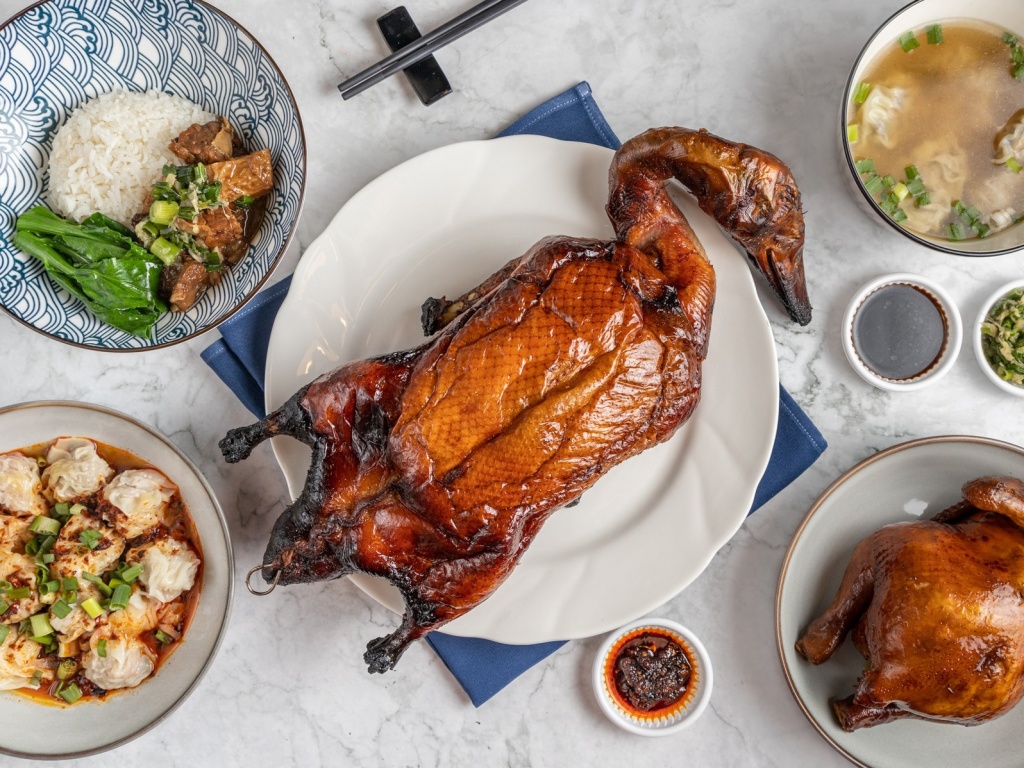
Why visit? Fatty Ox Hong Kong Kitchen checks off all the boxes of a good Hong kong siu mei (a Cantonese term for meats roasted over open fire) store. Be it the roasts, stewed beef, dumplings or even the noodles, the ingredients here are fresh, and the execution is spot on.
Cheung Sun Kwai had worked in various F&B spots in Hong Kong and eventually landed his first official job at the chain, Mayflower Restaurant. When the brand expanded into Singapore in the 1970s, he came along for the ride, and eventually ventured out on his own in 1986, opening Fatty Ox Hong Kong Roast Duck along Pagoda Street, and then a Murray Street shophouse.
When the landlord sold the shophouse and displaced him, Sun Kwai went into the hawker business under the new-ish name of Fatty Ox Hong Kong Kitchen at Chinatown Complex Food Centre in 2011.
Crowd favourites: You’d have to come early for its beef brisket noodle (S$6), which sells out within hours of its opening, usually before noon. Chunky cubes are braised till the fat and collagen melt into the luscious savory gravy. This gravy is then splashed copiously onto a bed of springy egg noodles.
What’s special are the pieces of tendon that come along with it — soft and barely needing any force before it breaks apart. It acts almost as a bouillon cube, having soaked up all the best flavours of the stew.
The barbecued meats glistening in the display are also worth trying, with the roast duck (from S$5 with noodles, or S$24 for half a duck and S$48 for a whole duck) being the standout. The duck leg is popular but the breast showcases Cheung’s expertise, though it is on the leaner side, much of the fat is stored right below the skin, which has been rendered away to give an extra crispiness to the skin here. Tip: You can contact the store at 96385345 to make orders in advance, especially if you’re getting a whole duck.
6. Xiu Ji Ikan Bilis Yong Tau Fu
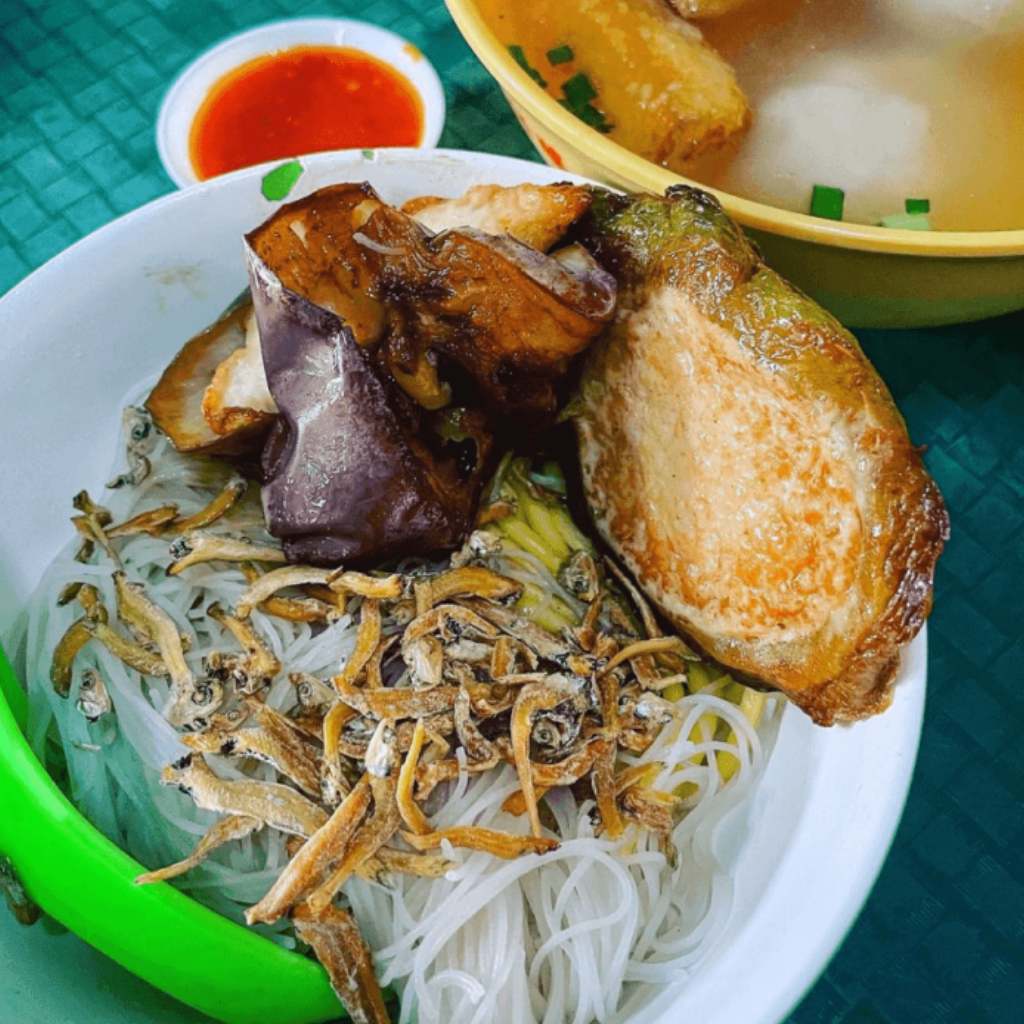
Why visit? This is perhaps one of the cheapest spots to get handmade yong tau foo in town. Xiu Ji Ikan Bilis Yong Tau Fu started out as a roadside stall along Sago Lane in the 1960s, and has always garnered long queues for its affordable and filling meals. Today, third-generation owner Lee Siew Khim and her husband continue that tradition at Chinatown Complex Food Centre.
It used to serve a mix of meat and fish paste yong tau fu, as per Hakka tradition, but now uses just fish, with its fish paste is made daily by a trusted supplier using its own secret recipe. The husband-and-wife duo continue to prepare the tofu and other ingredients by hand, a sight you’ll be greeted with if you come in the early afternoon.
Crowd favourites: The ingredients are fixed so simply order either the four pieces with bee hoon or noodles (S$4). The soya bean and anchovy broth here is on the lighter side, making for the ideal canvas for the fresh fish paste and tofu, of which is soft, fluffy and savory. The accompanying noodles — opt for a mix of bee hoon and yellow noodles for texture — may look unassuming but come with ample lashings of shallot oil and a spoonful of crispy ikan bilis for flavour. Don’t forget to grab a spoonful of its tangy chilli for more flavour.
You should also get its special item, the stuffed bitter gourd (S$0.80), which is sliced and filled with its signature fish paste, then fried till lightly browned. It comes with a soft crunch and fluffy insides, and delivers a gentle bitterness to whet your appetite.
Check out 14 must-try comforting yong tau foo stalls in Singapore
7. 80 Huat Huat
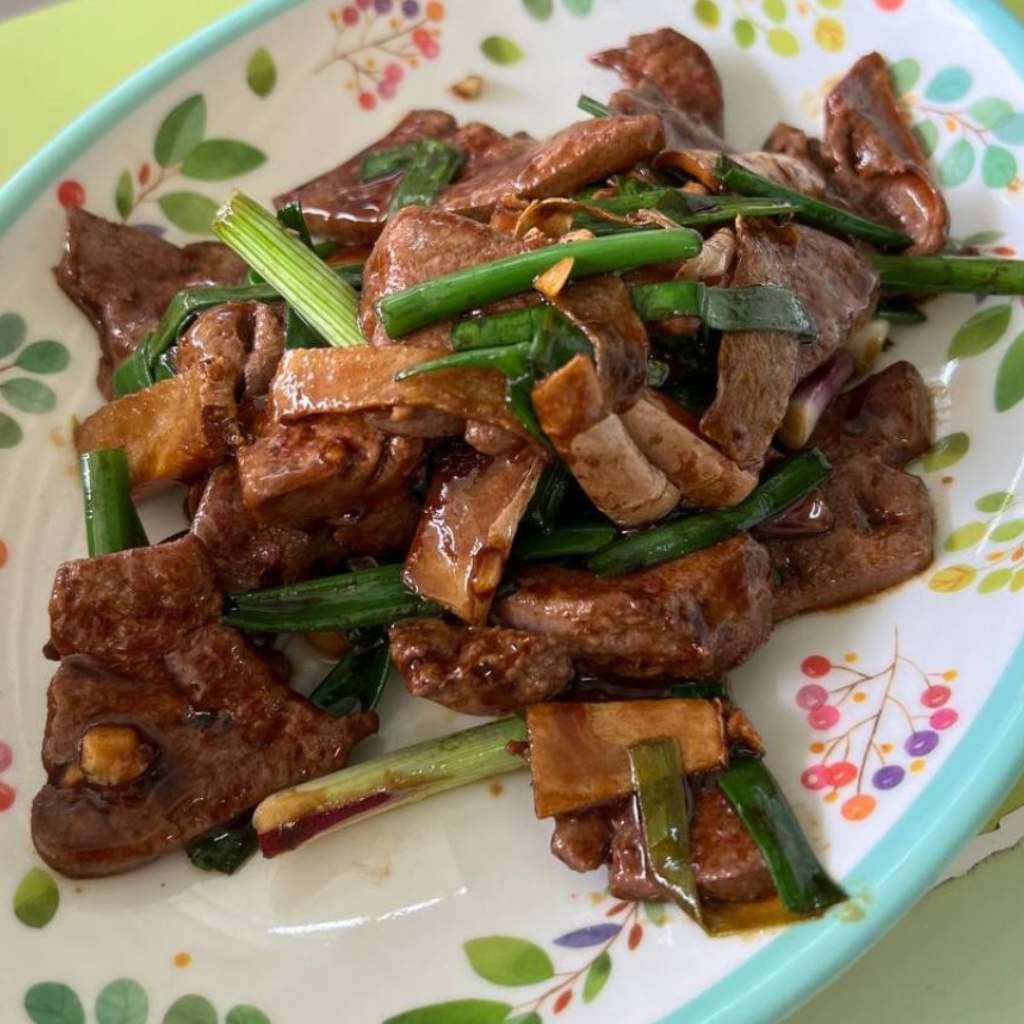
Why visit? There’s nothing quite as impressive as watching the chef of 80 Huat Huat frying up dishes atop a roaring flame, ingredients flying and sauces splattering, in a pristine white shirt. Which, I must add, stays stark-white till the end of the night — a mark of a true chef who knows his way around his kitchen.
While there are photos of its best sellers and a physical menu, regulars will tell you the gems are the dishes handwritten in Mandarin on a small whiteboard. It’s never exactly the same, and it all depends on what fresh ingredients uncle has procured for the day. If you’re not well versed in the language, simply ask the auntie at the stall (his wife), and she’d be more than happy to help. Prices here are also incredibly affordable for the quality.
Crowd favourites: The stir fry pork liver with ginger and spring onions (S$10) is a must-have. Uncle only uses fresh pig liver for this dish, from the wet market just downstairs, no less. Thick cuts are stir fried with an aromatic blend of ginger, spring onions, oyster sauce, sesame oil and hua tiao wine until tender and juicy, with just a hint of pink peeking through the dark gravy. It’s best to eat this quickly as the lingering heat would eventually overcook the liver. Enjoy this with white rice and ample spoonfuls of the gravy.
Another favourite is the soon hock, deep fried style (starts from S$30, depending on market price) — also sourced from the same wet market — where he simply lets the natural flavours of the marble goby shine. The whole fish is first spatchcocked, before it is deep-fried just enough for the skin to crisp up to a golden brown. The flesh remains delicate and meaty, and goes perfectly with the fragrant soy sauce it lays atop of.
8. Smith Street Taps
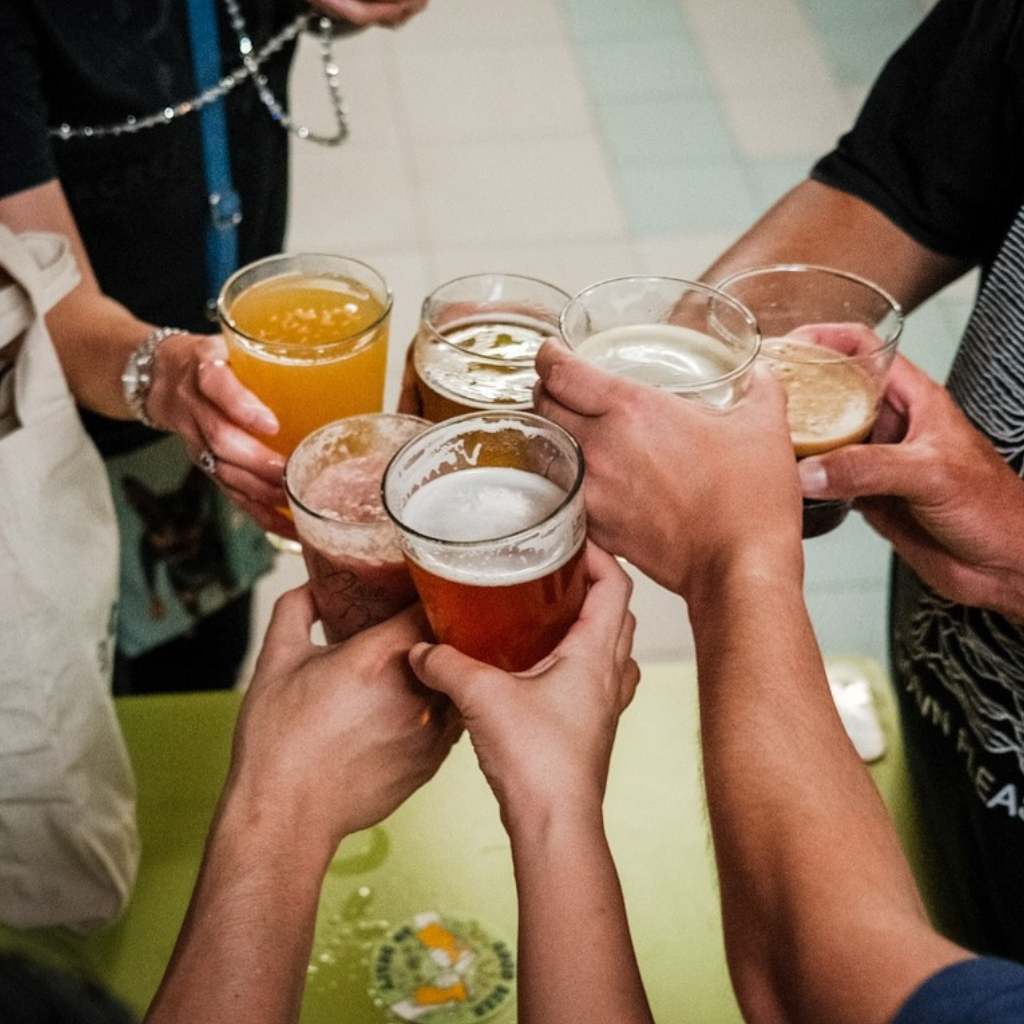
Why visit? Smith Street Taps is one of the pioneering forces behind Singapore’s craft beer scene. Back when there were only pop-ups or small gatherings to imbibe, founder-owner Meng Chao and his then-co-founder introduced craft beers to the mass Singapore audience with a humble store at Chinatown Complex Food Centre in 2013.
Fast forward to today, we now have craft beers across the island and even in supermarkets. But what keeps Smith Street Taps a hotspot for craft beer fiends is its affordable price range (with no service charge, too!), and an ever changing and exciting lineup of craft beers from local and international breweries.
Meng also has a distribution arm under the brand which keeps him at the forefront in bringing some of the world’s best taps into Singapore.
Crowd favourites: The menu changes frequently and if you love your beers, you can keep tabs easily online. While its taps feature a couple of breweries, you should always keep a lookout for ones such as Alive Brewing, which, in my short years of enjoying craft beers, is the best local brewery I daresay. Its seasonal brews are usually only available during festivals such as Beerfest, and Smith Street Taps is one of the few places you can enjoy a fresh pint from Alive quite regularly.
Those who enjoy their sour beers will enjoy One Drop Brewing Co. Inspired by Reggae music, this brewery hails from New South Wales, Australia. Whichever your preference, simply speak to the staff for recommendations.
Red zone
9. Heng Ji Chicken Rice
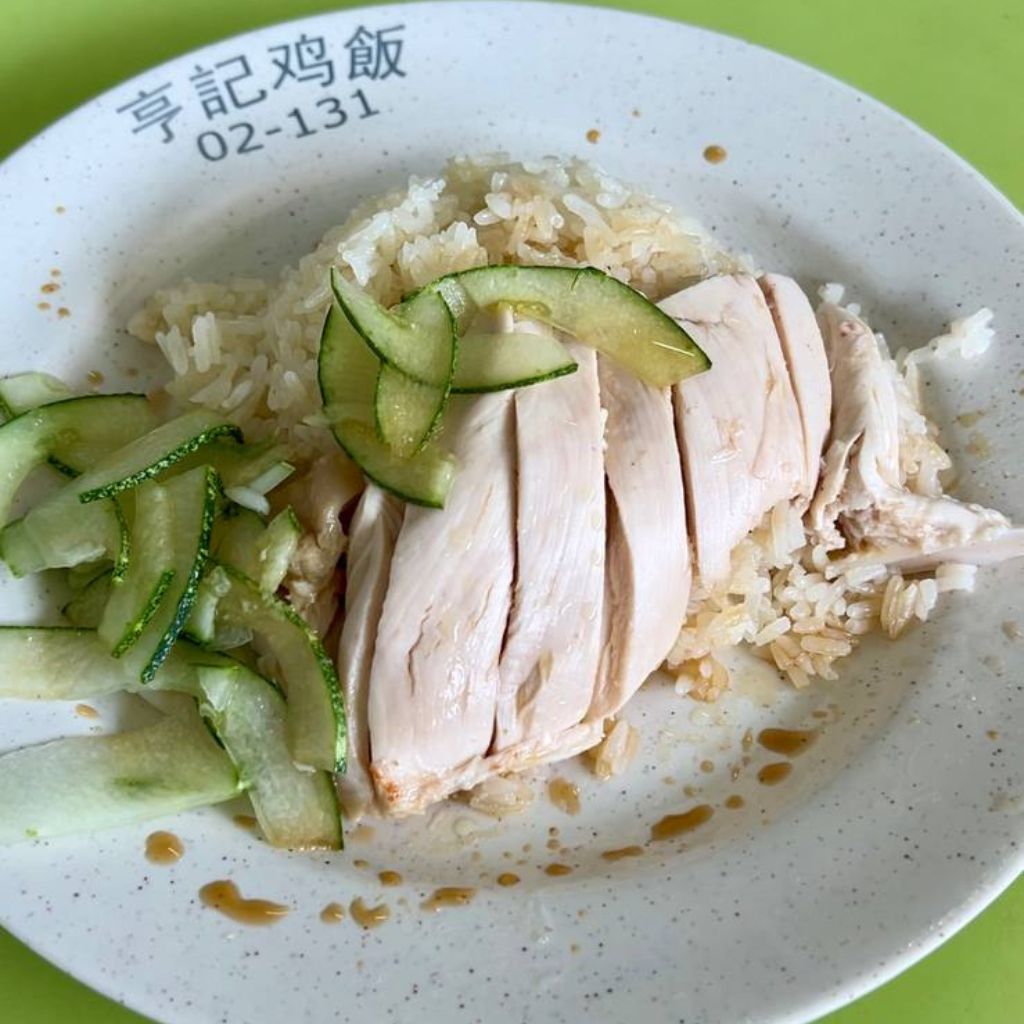
Why visit? This busy hawker within the red zone of Chinatown Complex Food Centre serves one of Singapore’s most traditional versions of chicken rice, where chicken is served with you fan (or oil rice in Mandarin). Heng Ji Chicken Rice first started out along Smith Street, before moving into the complex in 1983 along with many others.
Previously owned by the late Chan Yeow Seng, who took over the brand from his father, it is now owned by two cousins, Jersey Ng and Ng Li Peng. The duo fell in love with Chan’s chicken rice and seized the chance to learn from him for over a year, before finalising the sale of the hawker store in 2022.
Crowd favourites: The menu has not changed since it first opened — the menu is simply made up of its signature poached chicken with rice, and you simply have to decide how much you’d want and which part you’d like to indulge in.
The best way to enjoy Heng Ji Chicken Rice is to come as a group and go for half or whole chicken (S$14 or S$28 respectively) and about two bowls of rice per person (S$0.70 a bowl). Yes, two. This way, you’d get to enjoy the different cuts of the chicken, alternating between the different textures.
My personal favourites are the thighs and breast meat — the former is silky and fatty while the latter is plump and easily soaks up the aromatic dressing of light soy and sesame oil it sits upon. The rice here is a tad mushier than you might be used to, perhaps due to their use of broken rice grains, but is incredibly fragrant with shallots. Don’t be afraid to play around with its sauces, too, for the perfect combination.
10. Jin Ji Teochew Braised Duck & Kway Chap
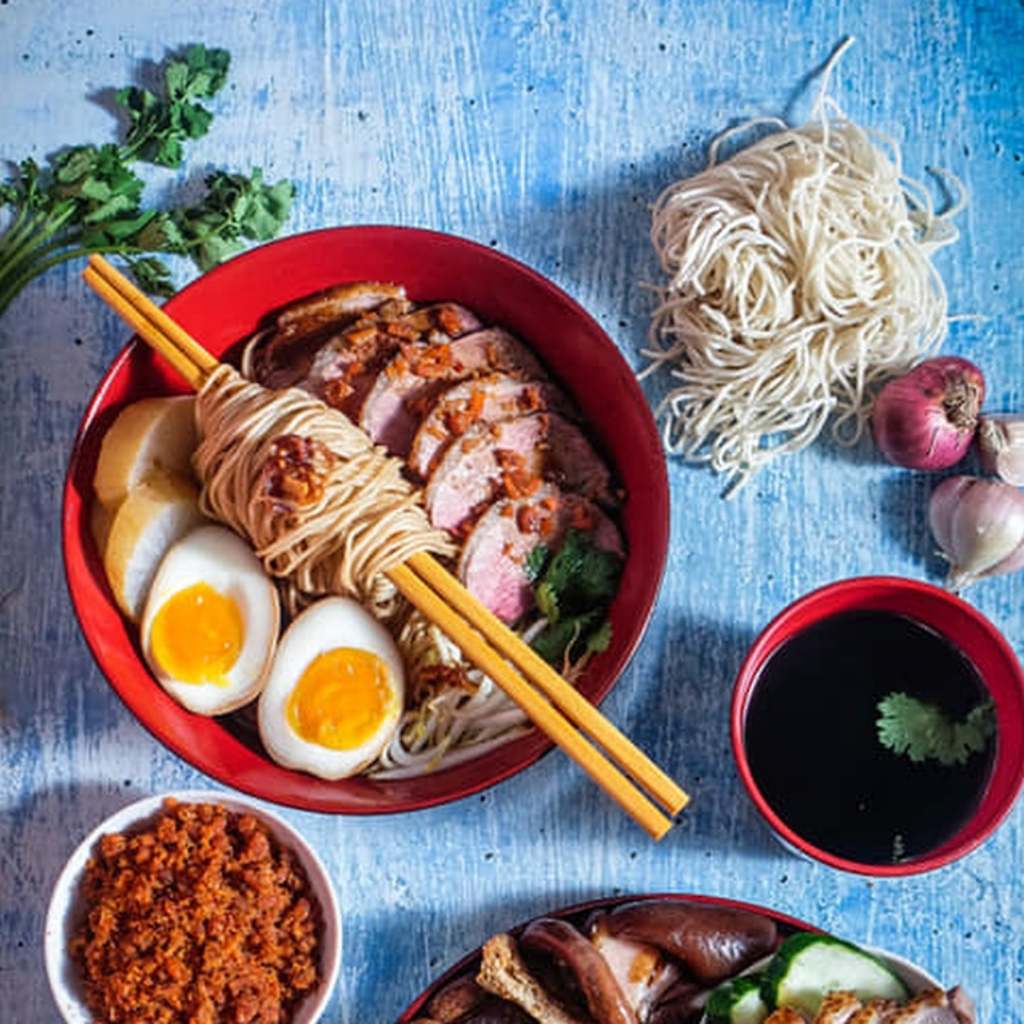
Why visit? Melvin Chew has been winning over regulars and new fans at Jin Ji Teochew Braised Duck & Kway Chap. Here, the second-generation hawker, assisted by his mother, Lee Bee Hong, strikes a balance between tradition and innovation, with his Japanese-inspired takes on its braised duck and kway chap dishes.
The stall was one of those that moved into Chinatown Complex Food Centre in 1983, and Melvin recalls spending much of his childhood here, helping out from a young age of seven. It was only in 2014, when his father passed away, did he take the initiative to hold onto the store and continue his father’s legacy, with his mother by side.
Crowd favourites: Come hungry and order the bento combo jumbo set (S$10). The massive plate is a great introduction to the store’s best. It comes with its homemade yam rice (shaped into balls and topped with fried shallots and garlic), a selection of its crowd-pleasing braised meats (duck, intestines and skin), an ajitsuke tamago (seasoned soft boiled egg), salted vegetables, and its house sambal chilli, redolent of dried shrimp.
The Quack ramen, dry (from S$6) is Melvin’s riff on duck noodles. In this dish, ramen noodles are used in place of typical yellow egg noodles, but the treatment is similar. Cooked till al dente, it is tossed a mix of its braising sauce, sambal chilli and dried shrimp. The braised duck is, needless to say, always top-notch. The layer of fat and its aromatic herbal note in the protein, is the proverbial cherry on top of this flavoursome bed of noodles.
11. Liao Fan Hawker Chan
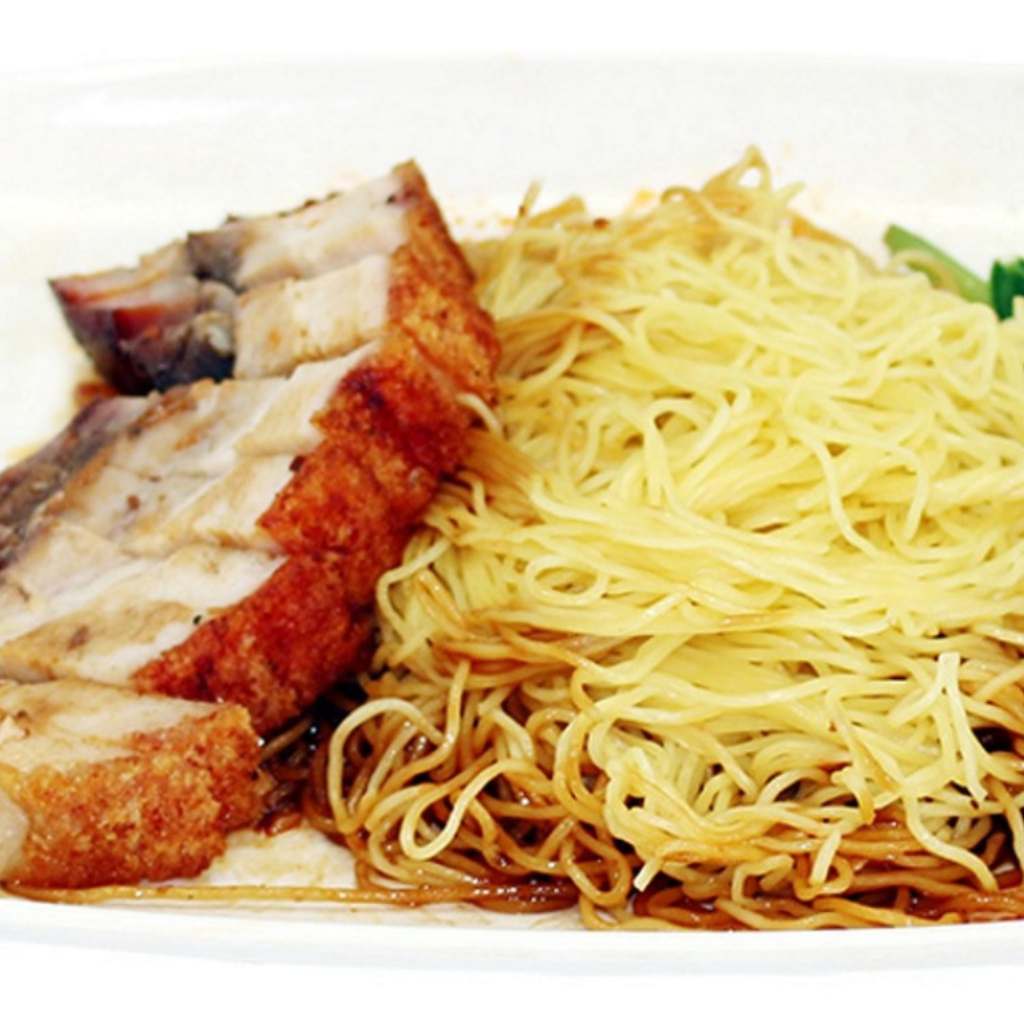
Why visit? Liao Fan Hawker Chan was a popular store even before the Michelin guide bestowed it a star in 2016. (It has since lost its star, and hasn’t been back on the list since 2021.) Star or not, it has always been loved for its soya sauce chicken at Chinatown Complex Food Centre, is no stranger to snaking queues during lunch. Despite having opened numerous branches locally and internationally, many still flock to the original.
Its owner Chan Hong Meng was a farmer boy in Ipoh, Malaysia before he made the move to Singapore in search of work. He lucked out with an apprenticeship under a Hong Kong chef and made a soya sauce chicken recipe he can put his name on. This eventually led to the opening of his first store in 2009, and many more since.
Crowd favourites: The soya sauce chicken rice (S$3.50) still remains one of the cheapest Michelin meals you can get in the world. It has all the markings of a great soya sauce chicken dish. The meat is moist and tender, imbued with a rich, savory flavour.
Those who are not fans of plain ol’ rice, opt for the soya sauce chicken drumstick hor fun (S$4.50). The fattier cut is, obviously, a winner, but even more so with the slippery ribbons of hor fun that easily takes on that sweet, savoury sauce.
12. Zhong Guo La Mian Xiao Long Bao
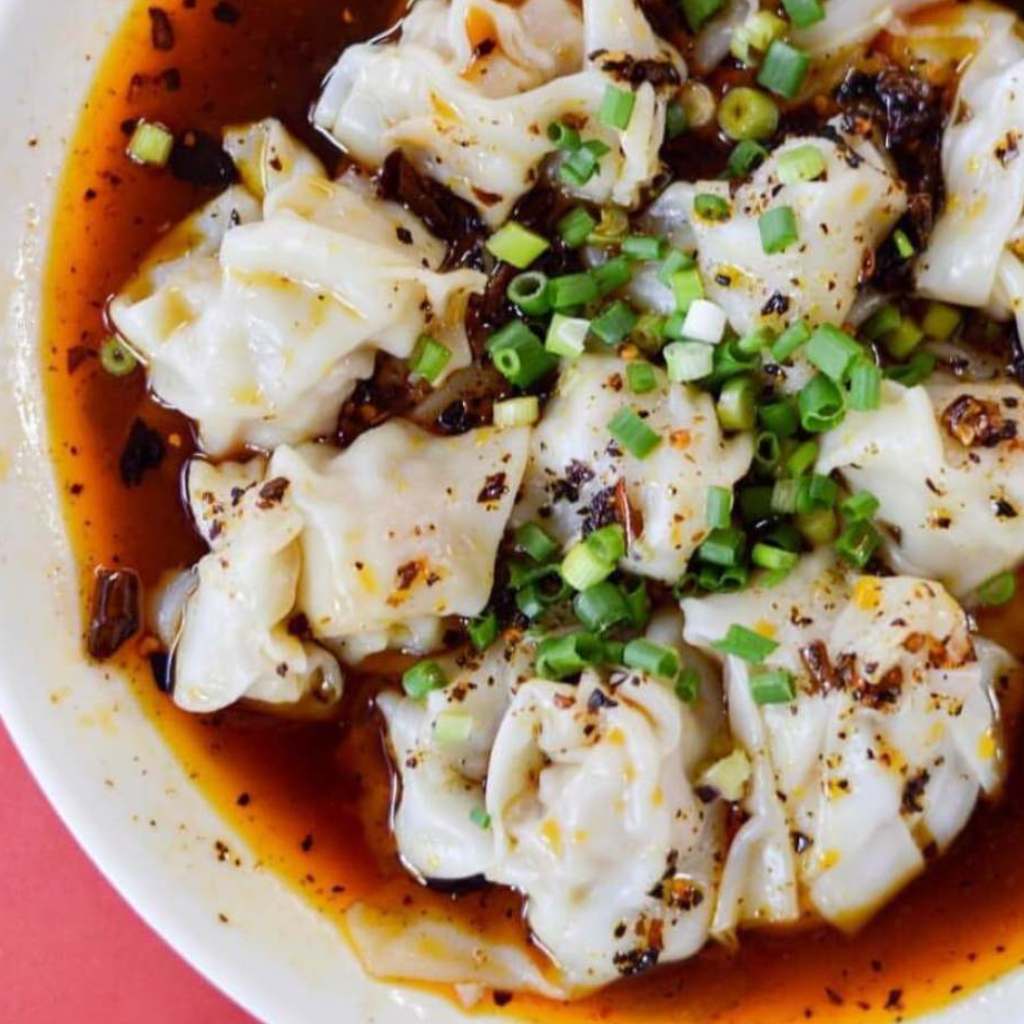
Why visit? Zhong Guo La Mian Xiao Long Bao is where you’d go for authentic northern Chinese cuisine staples of handmade noodles and dumplings, without breaking the bank. Li Feng Cai and his wife have garnered a loyal fan base since opening the store in 2008 and gained even more fans when it earned a spot on the Michelin Bib Gourmand list in Singapore, in 2018.
An Anhui native, chef Feng Cai honed his culinary skills in Beijing and Shenzhen, before moving to Singapore. He is most skilled in handmade noodles and dumplings, particularly xiao long bao or soup dumplings, all of which he and his wife continue to roll and fold by hand to this day.
Tip: You can also enjoy its dumplings at home — some of its items are also sold frozen, at S$12 for 20 dumplings or wontons and S$13 for 20 xiao long bao).
Crowd favourite: Its dumplings are steamed upon order, which is very much appreciated especially for items such as the xiao long bao (S$8 for 10 pieces). Its soup buns have a skin thin enough to give you a peek of what’s inside, but thick enough to handle even the most unskilled chopstick welder. Within, is a sweet, unctuous broth that the chef spends at least 12 hours on.
Another hot favourite is the Szechuan spicy wonton (S$7 for 10 pieces). Plump, taut-skinned wontons are served swimming in a fiery red sauce that’s fresh and vibrant, with just, surprisingly, a hint of heat. The stall also uses a brand of aged black vinegar that’s made from glutinous rice, and has a sweet yet fruit-like tartness (perhaps, akin to balsamic) that just whets your appetite.
13. Ann Chin Popiah
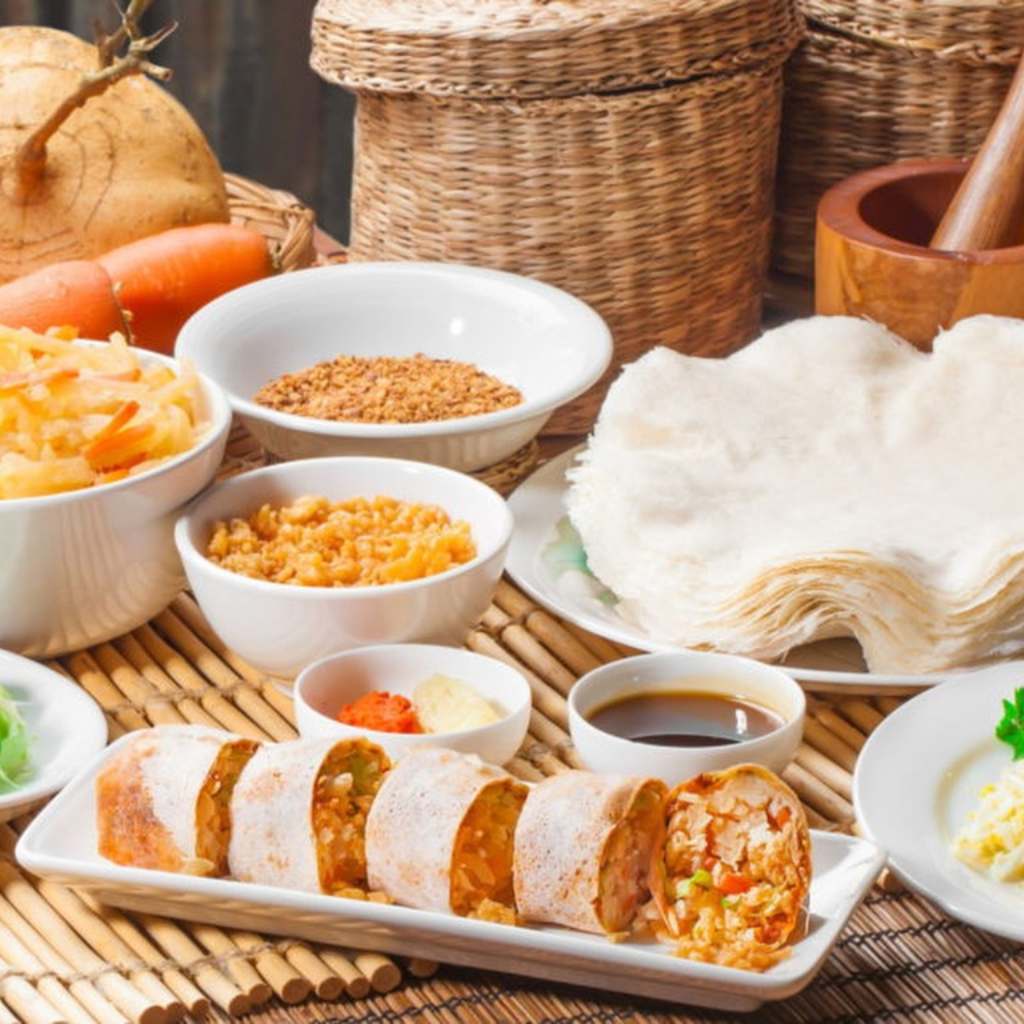
Why visit? Ann Chin Popiah is a household name for popiah and has been around for over six decades. While its stall at Chinatown Complex Food Centre is plenty popular, it has many others across the island, too, and also supplies to multiple vendors and hotels.
Fujian native Lim Kam Chwee started the brand in the 1950s, having mastered the skill of making thin-yet-chewy popiah skins. (We hear it takes six months to master how to make its skins!) Today, fourth-generation owner Pamela runs the brand with her mother, Wendy, innovating the preparation process and its products to cater to a bigger demographic.
Crowd favourite: If you had to choose an item to define the word popiah (S$2.20 per piece), it’d be Ann Chin’s, where its wafer-thin yet supple skin comes packed. You get a thick roll of its housemade sweet sauce, chilli sauce, lettuce, beansprouts, crushed peanuts, crispy flour bits, mashed up hard-boiled egg, and a hefty scoop of that sweet, stewed turnip. Some prefer it sliced up, but try my way: Have it as a roll and enjoy it like a burrito. Nothing falls out, and every bite is utterly satisfying.
For texture, there’s the kueh pie tee (S$3.70 for four pieces). Instead of the popiah skin, you get a thin and crisp pastry that’s filled with the same ingredient combination, which you can easily have in one mouthful.
14. Tai Wah Cooked Food
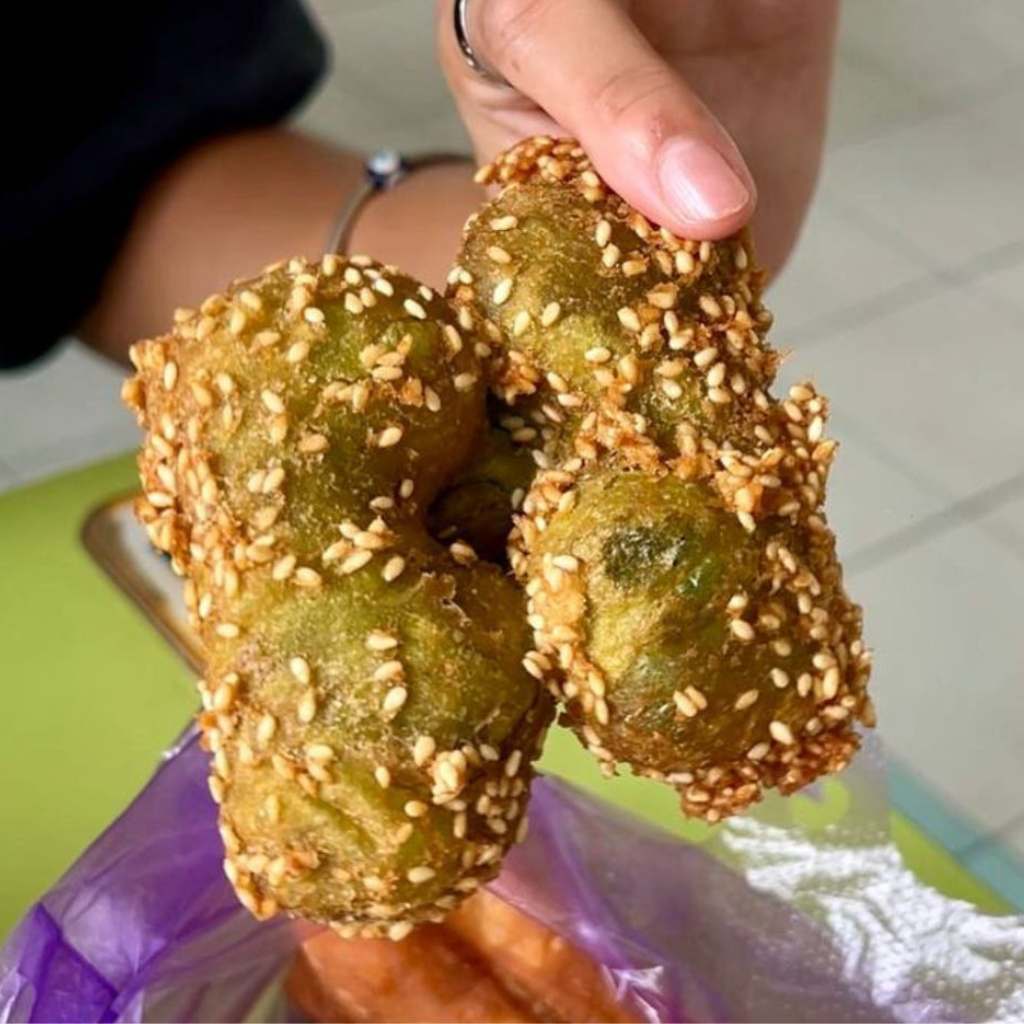
Why visit? Tai Wah Cooked Food specialises in traditional Chinese fried fritters, such as youtiao (Chinese dough stick), ham chim peng (deep-fried Chinese donut), and butterfly buns. This store is well-patronised by many but is in particular very popular among the older crowd because all of its fried goodies are priced at S$1 each — a rarity in today’s economy.
Given that it is a one-man operation, the wait might be slightly longer than you’d expect. Thankfully, the owner is efficient in his work, but the lines still form, especially when there is the promise of freshly fried butterfly fritters.
Crowd favourite: Its pandan butterfly (S$1) is a must-try. It comes coated with aromatic sesame seeds and a mild pandan flavour, with a crispy exterior and a fluffy inside. It’s so addictive that having one is honestly not enough — it is easy to see how .
Another popular item is the dough stick (S$1) or youtiao as it may be more commonly known . It’s a comforting snack adored by many and Tai Wah’s version is what you would expect of a good dough stick — not too oily and pleasantly chewy. You can also enjoy the dough stick with a bowl of tau suan (split mung bean dessert, S$1.70) if you have more space in your tummy.
Blue zone
15. Ma Li Ya Virgin Chicken
Why visit? You can’t talk about soya sauce chicken without mentioning Ma Li Ya Virgin Chicken. Owner Maria Siew Pui Yin is one of the OG stalls that served up this dish in Singapore, having inherited the recipe from her father, a partner at the famed New Nam Thong Tea House on Smith Street. (If you’re old enough, you might just remember having dim sum breakfasts or soy sauce chicken noodles at that spot.)
Maria earned her chops, not by blood, but through hard work. She worked at said tea house since she was nine years old and when the tea house eventually closed, she started her hawker venture at People’s Park, before eventually settling at Chinatown Complex Food Centre.
Crowd favourite: The heart of the menu is obviously its signature virgin chicken (from S$13 for half a chicken), which is downright lovely. Each plate comes with the protein chopped up into large chunks, bone-in, with an overabundance of a fragrant sauce. It is sweet, savory as you’d expect, but what surprises me is the lingering soya bean and herbal flavour in the sauce. The meat is cooked perfectly, exemplified by the pink around the bone — tender, juicy and made even better with the sauce.
Always order its signature braised beancurd (S$1.80 per piece). The jiggly Japanese-style silken tofu is an excellent canvas for the aforementioned sauce. In fact it is not uncommon to see regulars swing by just for the beancurd. Even its minimum required order of five pieces without the chicken doesn’t seem to have deterred anyone.
16. Lian He Ben Ji Claypot
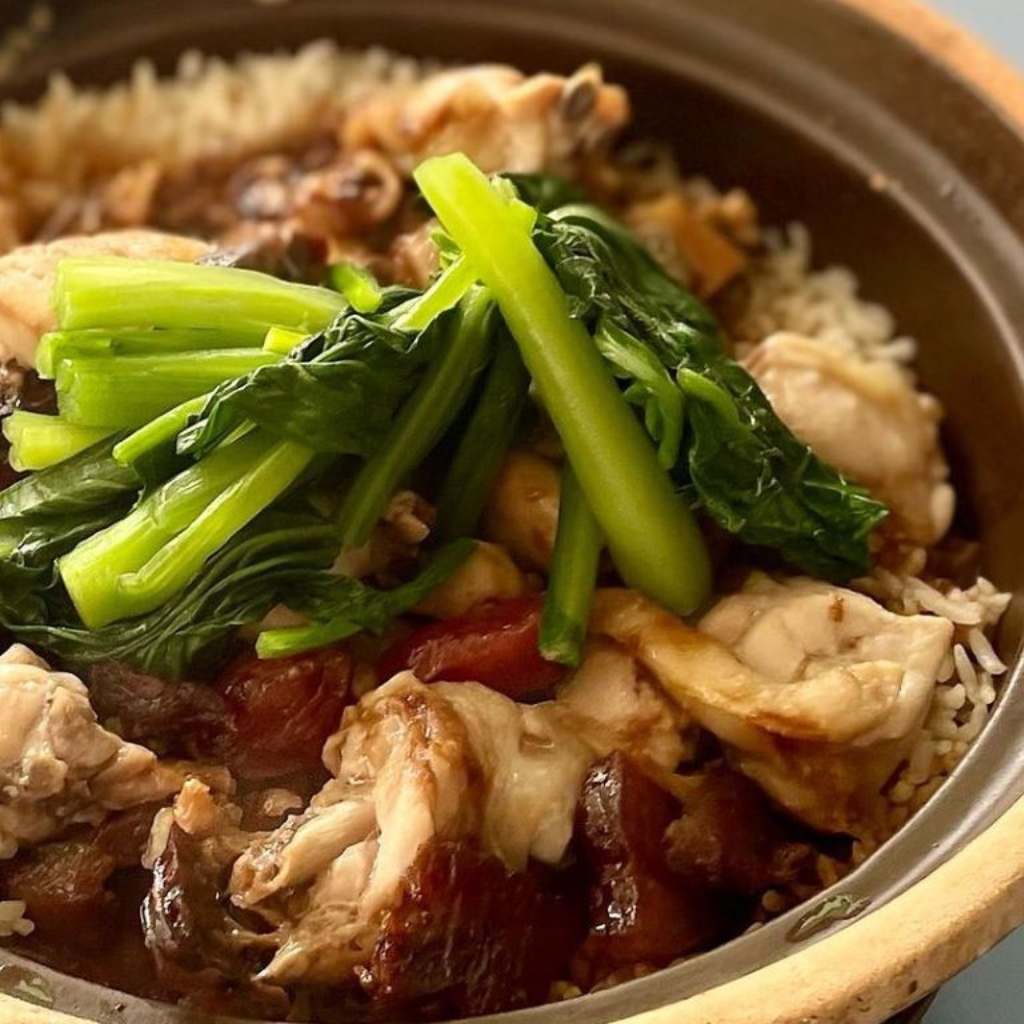
Why visit? Lian He Ben Ji Claypot, or known to some as “Three Sisters’ Claypot Rice”, stays true to tradition. It spans two hawker stalls, with one solely for housing rows of roaring charcoal fire stoves, ever-ready to cook up your orders a la minute.
It started out in 1979 as a street stall before moving into the food centre like its neighbours. Madam Lim, who currently runs the store, is a second-generation hawker, who picked up the trade from her father-in-law. When she took over completely, she enlisted the help of her two sisters. You can call in to 6227 2470 to order in advance since each pot takes a while to whip up — 30 minutes, to be exact.
Crowd favourite: There’s a bit of waiting time, but your patience will be well rewarded — Madam doesn’t skimp on ingredients or the time it takes. Each claypot mixed rice (from S$8) starts off with raw rice, which is first steamed over a gas stove, before it is transferred to the charcoal flame with a variety of ingredients.
The consistent heat of the claypot not only gives us fluffy grains and guo ba (crispy rice bottoms), but also infuses the flavours of its ingredients — chicken, lup cheong (Chinese sausage) and duck liver preserved sausage — into every grain. The finishing touch of a generous drizzle of soya sauce and shallot oil, gives off an aroma that is honestly irresistible.
Aside from its titular dish, it also serves up Chinese boiled soups that come loaded with goodies — a popular choice is the old cucumber pork ribs soup (S$2.50). Light on the palate, it has a refreshing flavour accentuated by the savoury ribs.
17. 1030 Breakfast Shop
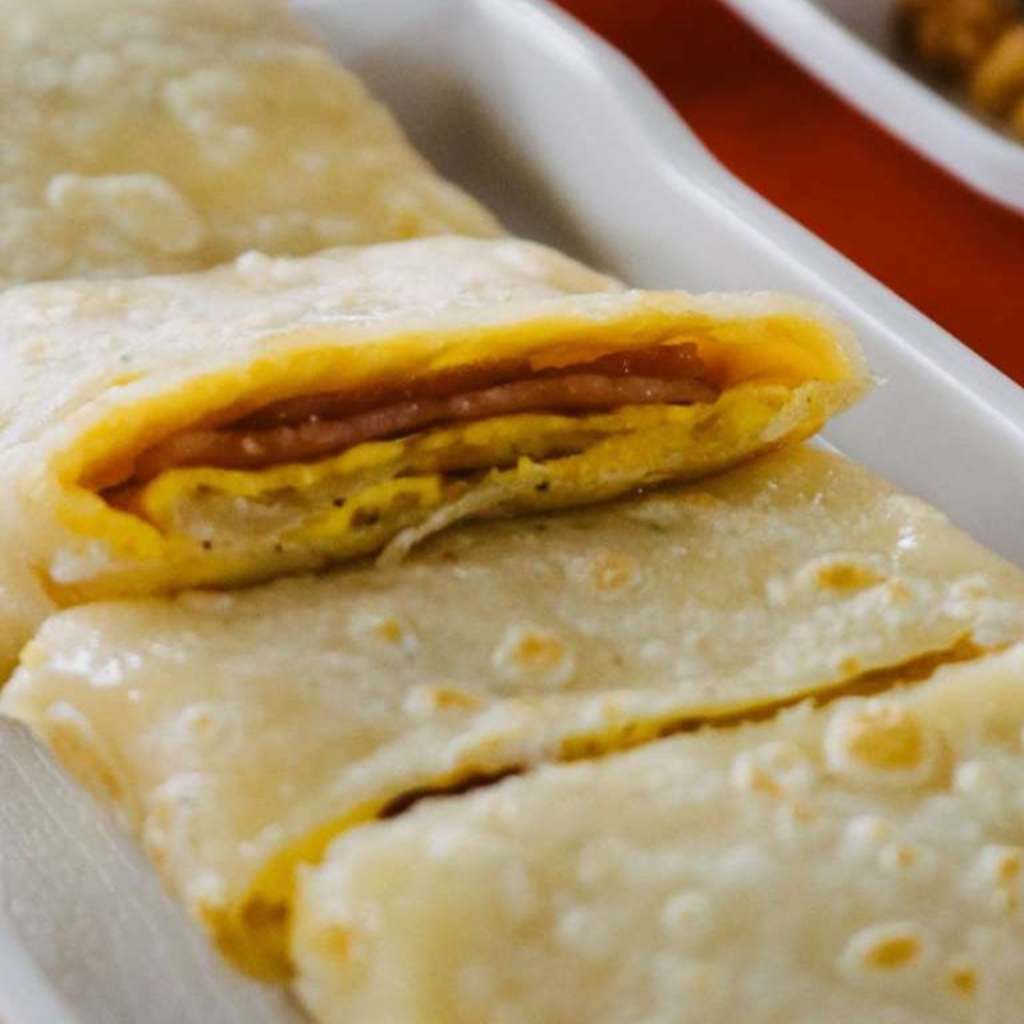
Why visit? If you’re missing Taiwanese-style breakfast from your trips to the country, 1030 Breakfast Shop has got you covered with its comforting and affordable Taiwanese breakfast fare, starting from S$2.
Though this new hawker store is located in the less-frequented blue zone of Chinatown Complex Food Centre, it’s quite impossible to miss 1030 Breakfast Shop’s prominent light pastel yellow signboard. You’ll also likely catch the two young sisters dishing out freshly made dan bing (Taiwanese egg pancake) and loaded toasts, with none of its items costing above S$6.50.
Crowd favourite: Go for its Signature toast (S$6.50), which is chock-full of delicious ingredients — it comes with slices of pork chop, egg, luncheon meat, and cheese sandwiched between two slices of toasted white bread. The elements are all well tied together with the creamy peanut butter jam that complements the heftiness of the proteins.
Dan bing (or egg pancake) lovers shouldn’t leave without ordering the ham cheese egg omelette (S$5) — a tried-and-tested combination that you can’t go wrong with. Its rendition of dan bing has a slightly crispy skin and chewy body, and isn’t in the least bit oily, making for a simple and satisfying dish.
For more ideas on what to eat, read the newest openings here.
